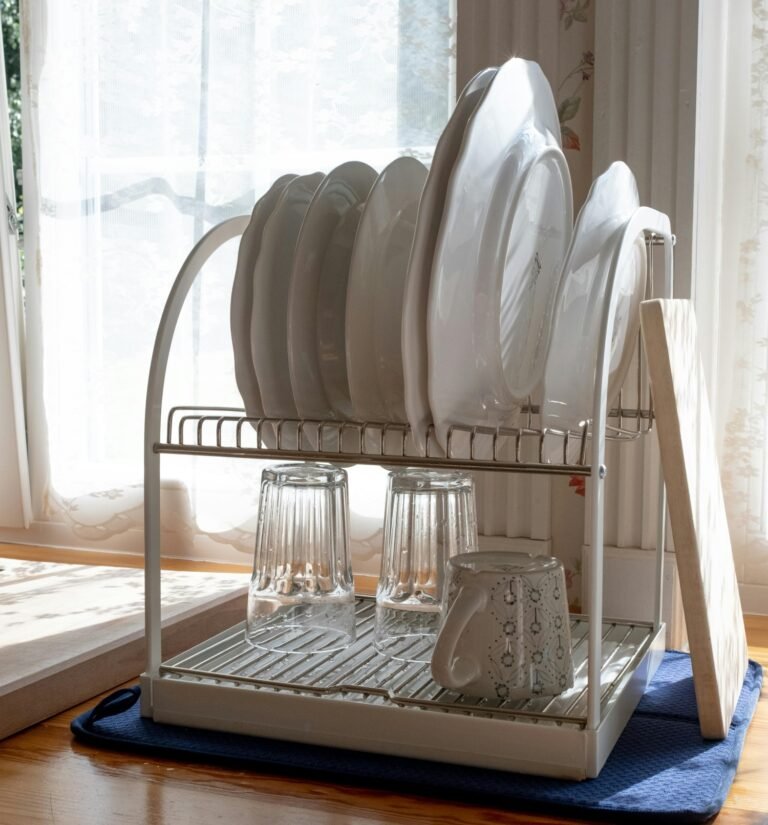A well-organized kitchen not only improves efficiency but also adds a sense of calm and cleanliness to the space. One of the most overlooked yet essential tools in any kitchen is the dish rack. Whether you hand wash your dishes daily or just need a place for drying occasional items, choosing the right dish rack can make a big difference in how your kitchen functions. In this guide, we’ll explore the various types of dish racks, their features, and how they can help you maintain an organized and clutter-free kitchen.
What is a Dish Rack?
A dish rack is a simple, structured stand that allows dishes, utensils, and cookware to dry after washing. Made from materials such as plastic, stainless steel, or bamboo, dish racks come in a variety of designs, from compact countertop models to larger, multi-level systems.
Benefits of Using a Dish Rack
- Efficient Drying: Proper air circulation around the dishes helps them dry faster and prevents water spots.
- Prevents Water Damage: Dish racks typically come with drip trays or draining systems to prevent water from pooling on your countertops.
- Space Saver: Many dish racks are designed to make the most of limited space, keeping counters free from clutter.
- Organized Kitchen: A designated place for drying dishes keeps your kitchen looking tidy and well-maintained.
- Reduces Bacteria Growth: Air drying dishes reduces moisture retention, which in turn minimizes the growth of bacteria and mold.
Types of Dish Racks
1. Countertop Dish Racks
These are the most common and versatile dish racks. They come in various sizes and designs, with space for plates, bowls, glasses, and cutlery. Some include additional features like utensil holders or foldable trays.
2. Over-the-Sink Dish Racks
Perfect for small kitchens with limited counter space, over-the-sink racks are mounted directly over the sink, allowing water to drain directly without taking up valuable countertop area.
3. Foldable Dish Racks
Ideal for those who want a dish rack that can be easily stored when not in use, foldable dish racks collapse flat, making them perfect for small kitchens or homes with limited storage space.
4. Two-Tier Dish Racks
For households with lots of dishes, a two-tier dish rack offers more drying space. These racks maximize vertical space and often come with separate compartments for utensils and glasses.
5. Wall-Mounted Dish Racks
A wall-mounted option is ideal for kitchens with limited counter space. These racks are mounted to the wall and come in various designs, including foldable models and multi-level shelves.
Best Uses for Dish Racks in Your Home
1. Drying Dishes and Utensils
The primary function of a dish rack is to allow dishes to air dry. Choose a rack with adequate space for your regular dishwashing load and ensure it has sufficient ventilation for faster drying.
2. Storing Cutting Boards and Trays
Some dish racks come with sections specifically designed for larger items like cutting boards or trays. This helps keep these bulky items off the counter and out of the way.
3. Organizing Pots and Pans
Certain dish racks feature larger compartments for drying or storing pots, pans, and lids, making them perfect for chefs or households that cook frequently.
4. Drying Glasses and Stemware
For fragile glassware, such as wine glasses, opt for dish racks with padded or cushioned sections to prevent scratches or breakage.
Pro Tips for Choosing the Right Dish Rack
- Measure Your Space: Before purchasing, measure the available counter or sink area to ensure your dish rack will fit comfortably.
- Look for Anti-Rust Materials: Stainless steel or plastic dish racks are ideal for preventing rust or corrosion in high-moisture environments.
- Consider Easy Maintenance: Opt for dish racks with removable trays and parts for easy cleaning.
- Opt for Draining Systems: Some dish racks come with angled trays that allow water to drain directly into the sink, preventing water buildup.
- Think About Style: If your dish rack will be a permanent fixture on your counter, choose one that complements your kitchen decor.
Pros and Cons of Different Dish Rack Materials
| Material | Pros | Cons |
|---|---|---|
| Stainless Steel | Durable, rust-resistant, sleek appearance | Can be expensive and heavier |
| Plastic | Lightweight, affordable, easy to clean | May stain or discolor over time |
| Bamboo | Eco-friendly, natural look | Requires more maintenance and care |
| Chrome-Plated Steel | Budget-friendly, stylish | Prone to rust if not dried properly |
Overcoming Common Dish Rack Challenges
- Limited Counter Space: Opt for an over-the-sink or wall-mounted dish rack to save precious counter space.
- Water Pooling: Choose a dish rack with a built-in draining system or a removable drip tray to prevent water from pooling underneath.
- Mold or Bacteria Growth: Regularly clean your dish rack and ensure proper air circulation around dishes to reduce the risk of mold or bacteria.
- Storage Issues: If you’re tight on storage, a foldable dish rack can be easily stored away when not in use.
- Dish Rack Size: If you frequently wash a large number of dishes, opt for a two-tier rack to maximize drying space.
Conclusion
A dish rack is more than just a functional tool—it’s a key part of keeping your kitchen organized and efficient. With so many designs and features to choose from, finding the right dish rack for your kitchen will not only make drying dishes easier but will also keep your space looking neat and clutter-free.
Ready to upgrade your kitchen organization? Check out this essential dish drying rack to get started on your journey to a tidy and functional kitchen: https://amzn.to/4eFn417
As an Amazon Associate, I earn from qualifying purchases.
Last updated on May 19, 2025







